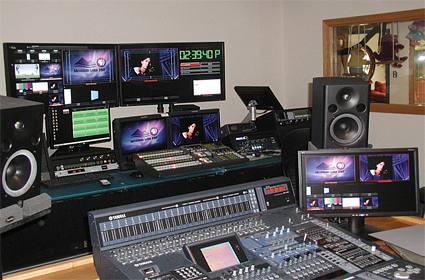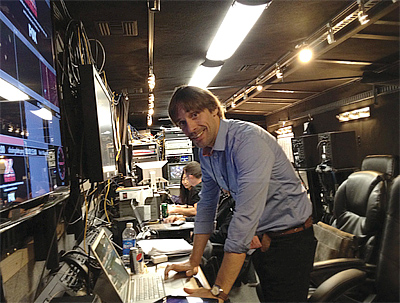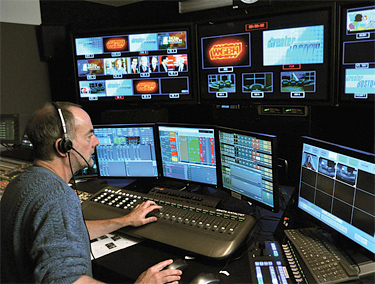Live TV Orchestrated by a One-Man Band
HAMILTON, N.J.: As the name implies, Integrated Production Systems (IPS) integrate all the functionality needed for a live HD broadcast—like motion graphics, effects and titles, mixing audio, rolling in clips, multi-viewer monitoring and robotic camera control—into a single system. Since all tools are accessible from a single interface, a "one-man band" can run the whole show.

Mountain Lake PBS installed its new Broadcast Pix Granite 5000 live video production system last October. These systems are gaining in popularity due to their cost-efficiency, streamlined workflow, portability, and user-friendliness, especially for budget-constrained productions.
"If we had used a traditional HD control room or truck, it would have been cost-prohibitive, required more space, and added layers of technical complexity to our workflow," said Marc Scarpa, producer/director for "The X Factor Digital,"
For "The X Factor," the primetime singing competition judged by Simon Cowell and Paula Abdul, Scarpa produced a live pre-show, including behind-the-scenes access, for Web, tablet, and mobile consumption during the Fox broadcast, using two TriCaster 850 Extreme IPS by San Antonio-based NewTek.
For "The X Factor" pre-show, a single TD/operator used TriCaster to switch four live 720p HD camera signals, incorporate fan input from Twitter, FaceBook and Skype, and produce a polished live streaming experience.
"Online broadcasters tend to be younger, and don't generally have the budgets of more established productions, so they're looking for innovative ways to get their shows made cost-effectively," Scarpa said. "This younger generation is realizing early in their careers that you don't need to spend millions of dollars on equipment to produce high-value broadcasts and that will impact the way they work going forward. This trend is changing the way live television is produced."
Philip Nelson, senior vice president of strategic development for NewTek said, "TriCaster provides the core functionality of a TV truck in a device that's portable and easy to use. We're empowering content creators to get shows produced despite limited budgets."
Nelson adds that NewTek is seeing added interest in Tricaster for "shoulder programming," which he describes as "typically streaming media for Web, tablet, or mobile audiences to build excitement for the main broadcast." At X Games 17 last summer, ESPN used TriCaster 850 Extreme to deliver streaming content for all of its webcasts, including its "X Cast" show, which serves as a preview and recap of competitive events.

Marc Scarpa, producer, director for "The X Factor Digital," produced on NewTek's Tricaster 850 Extreme.VALUE-CONSCIOUS APPROACH
"I needed to get the best bang for the buck," said Charlie Zarbo, director of engineering for WCFE, a Mountain Lake PBS member station in Plattsburgh, NY. "We needed to do a complete upgrade of our studios from analog, skipping over SD, and going directly to HD.
"This meant we needed a lot of HD capability all at once, and I'd have to spread limited funds over a wide range of HD devices," Zarbo said. "We went with Granite because it integrated everything we needed within a single HD system. It's a pretty good bang for the buck."
In October 2011, Mountain Lake PBS replaced an aging Grass Valley 200 switcher with a Broadcast Pix Granite 5000 live video production system, (ranging from 11 to 22 inputs plus 12 outputs). It integrates a 2-M/E switcher with Harris Inscriber GS CG, multi-view display using DVI monitors, audio, camera control, and clip store, among other "Fluent" workflow tools. "PixButtons" dynamically display sources and file names on the user interface.
"The industry is coming to understand that systems like Granite offer greater cost-efficiency by putting all necessary production functionality in one box," said Paul Lara, marketing director for Boston-based Broadcast Pix. "This results in a streamlined workflow where a single operator can control all aspects of a live show, saving production overhead and space."
An entry level 1-M/E Granite 500 was installed on Riverside (California) Government Television's space-challenged production van used to produce programming for the City of Riverside's public, educational, and government (PEG) channel. Soon after Granite was installed, the van covered a University of California Riverside basketball game live as well as high school football games. At NAB, Lara said Broadcast Pix will show a new virtual set feature, as well as Mica, an 8-input version at a competitive price-point.
GETTING IN CONTROL
When federal grant money for PBS stations began drying up, WGBH Boston took decisive action to preserve the quality of its signature programs, including public affairs shows "Greater Boston" and "Basic Black."
They automated with the Grass Valley Ignite live production system, which gives a single TD/operator control over the Grass Valley Kalypso Duo production switcher, among other control room devices.

The Grass Valley Ignite setup at WGBH -TV. Rather than a frenetic rush prior to air, the Ignite workflow pushes preparation of media assets, graphics, and the show rundown earlier in the day. While the switcher can be controlled from Ignite's Katalyst control panel, WGBH kept Kalypso's manual control panel in case producers prefer a traditional workflow.
"In some situations, you might not want to turn your entire operations over to an automated system," said Ed Chuk, director of production services, WGBH. "This allows us to have access to both types of system control." Chuk credits Ignite for WGBH's smoother production schedule, cost savings, and fewer on-air technical errors.
"We designed Ignite to be flexible enough for any production scenario, from fully automated to unscripted," said Scott Matics, Grass Valley's Ignite Product Manager. "It interfaces with newsroom systems via a MOS gateway, but is not dependent on them during air. If there's breaking news during an automated production, the operator can take the reins and control devices on the fly."
PRODUCE & DISTRIBUTE
VDESK II and REMO II systems from Dallas-based Rushworks integrate live HD/SD production functionality—camera control of pan-tilt-zoom cameras, digital video effects, titles, audio and clip store—in a compact, low-cost, turnkey package.
"Our systems allow users to produce and distribute live, multi-camera shows using a touchscreen monitor," said Rush Beesley, president of Rushworks. "The dynamic interface is so intuitive a single operator—even someone with no video skills—can produce a broadcast-quality show with minimal instruction."
VDESK II and REMO II record and output MPEG-2, Windows Media, AVI formats, and eventually MPEG-4. While VDESK II is a small console for a fixed location, REMO II fits in a 40-pound "lunchbox." Topeka-based Cool Music Network uses REMO II to record live music at rock concerts nationwide for multiplatform distribution, according to Beesley. "And the City of Dallas already saved $100,000 using REMO II instead of hiring trucks to produce and stream meetings and events."
Christ Kingdom Church, in Washington, D.C., uses VDESK II to produce an online telecast of worship services. "In minutes, I'm ready to run multiple cameras, switch between them, add transitions, and pipe it out to the Internet," said Fred Taylor, the Church's media minister. "Just as you would broadcast a television show or sports event, we're now right in the same league."
Get the TV Tech Newsletter
The professional video industry's #1 source for news, trends and product and tech information. Sign up below.

